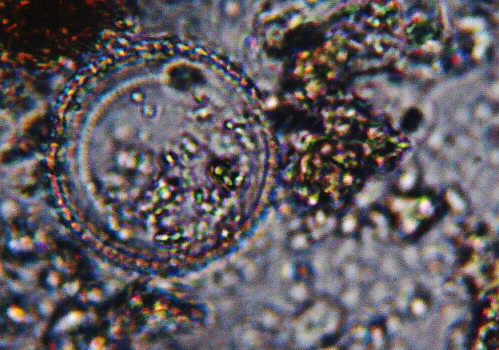 "Max's Minions" is the informal name for WSC's junior research volunteer program. The Minions perform a variety of lab duties for us, including 3D scanning, molding and casting, skinning carcasses for our dermestid colony, preparing fossils, and other tasks. Several of them are also working on their own research projects.Western Center Academy student Sianna Xiao has been pulling sediment samples off our small collection of fossil bones and shells from Neogene deposits in Virginia. Using a protocol developed some years ago by one of my former student interns, Anna Trochim, she has been preparing those samples for studying their diatoms.Diatoms are single-celled eukaryotic algae that live in the water. An important characteristic of diatoms for paleontologists is that they secrete a cell wall (called a frustule) that is made of silicon dioxide; essentially, they have glass shells. This means that they preserve well as fossils.Diatoms are one of the main things we use to determine environmental conditions, as various species may be sensitive to changes in salinity, temperature, pH, or other factors. Since they are photosynthetic, they depend on sunlight, so forms that live on the seafloor can only live in shallow water (less than 100 m, and usually less than 20 m). They are also one of the main organisms used in Cenozoic marine biostratigraphy, meaning they are important for determining the age of marine deposits. So there is an abundance of reasons to study diatoms.One of Sianna's samples comes from the Miocene Calvert Formation at the Carmel Church Quarry. Anna and I published the Carmel Church diatom flora a few years ago, but since we know it contains diatoms it's a good way to learn the sample protocol and practice identifications. The image above is one of the most common species at Carmel Church, Paralia sulcata. As expected, it's one of the most common in Sianna's slides as well. This species, while common, has a tremendous temporal range m(from the Cretaceous to Recent), so it's of no biostratigraphic value. It also can live in seawater ranging from brackish to normal salinity, and also lives in a variety of environments, so it doesn't actually tell us a whole lot about the age or paleoenvironment. But 27 other species are known from Carmel Church so far, so there will be plenty more to see.
"Max's Minions" is the informal name for WSC's junior research volunteer program. The Minions perform a variety of lab duties for us, including 3D scanning, molding and casting, skinning carcasses for our dermestid colony, preparing fossils, and other tasks. Several of them are also working on their own research projects.Western Center Academy student Sianna Xiao has been pulling sediment samples off our small collection of fossil bones and shells from Neogene deposits in Virginia. Using a protocol developed some years ago by one of my former student interns, Anna Trochim, she has been preparing those samples for studying their diatoms.Diatoms are single-celled eukaryotic algae that live in the water. An important characteristic of diatoms for paleontologists is that they secrete a cell wall (called a frustule) that is made of silicon dioxide; essentially, they have glass shells. This means that they preserve well as fossils.Diatoms are one of the main things we use to determine environmental conditions, as various species may be sensitive to changes in salinity, temperature, pH, or other factors. Since they are photosynthetic, they depend on sunlight, so forms that live on the seafloor can only live in shallow water (less than 100 m, and usually less than 20 m). They are also one of the main organisms used in Cenozoic marine biostratigraphy, meaning they are important for determining the age of marine deposits. So there is an abundance of reasons to study diatoms.One of Sianna's samples comes from the Miocene Calvert Formation at the Carmel Church Quarry. Anna and I published the Carmel Church diatom flora a few years ago, but since we know it contains diatoms it's a good way to learn the sample protocol and practice identifications. The image above is one of the most common species at Carmel Church, Paralia sulcata. As expected, it's one of the most common in Sianna's slides as well. This species, while common, has a tremendous temporal range m(from the Cretaceous to Recent), so it's of no biostratigraphic value. It also can live in seawater ranging from brackish to normal salinity, and also lives in a variety of environments, so it doesn't actually tell us a whole lot about the age or paleoenvironment. But 27 other species are known from Carmel Church so far, so there will be plenty more to see.

